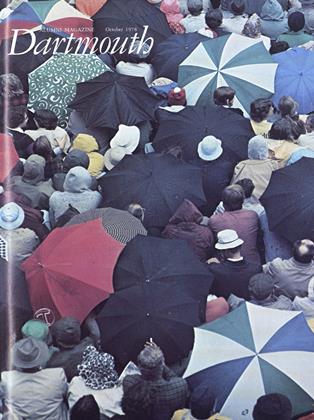Summer or winter, forecourt or ski slope, these two books are designed to help you do better what you already do well. They are not for beginners, but they are for amateurs. Let's take winter first.
Loudis and Lobitz are psychologists; both hold doctorates in their field; both teach in universities. So what, you may ask, do a couple of professional psychologists know about skiing? "Probably no more than any other group," they themselves confess. But "what we do know is something about how people learn and how they change their behavior."
That, then, is what their book is about. Skiing is a stress-inducing sport, they claim, because the name of the game is risk. But inherent risk is double-edged: it is the source of the skier's psychic problems all right, but it is also the source of matchless exhilaration. Assuming that you have already picked up some bad habits on the slopes and that these have transferred themselves into psychic anxieties beyond your conscious control or even knowledge, Loudis and Lobitz show you step by step how to use those psychological strategies which can change not the skiing itself but your attitude toward skiing, or your attitude toward yourself skiing. They hope to teach you, they say, "to reapply - this time for the better - the psychological principles that led you into difficulty in the first place." Their regimen requires self-discipline; it "requires your active participation and involves behavioral psychology combined' with aspects of Eastern philosophy:, experiencing and thinking, inner and outer awareness, right-brain and left-brain activity." For Loudis and Lobitz skiing is an unusually heady experience.
But now to summer. If your tennis game suffers from tired blood, if you are fed up with lollygagging around the baseline and want to get up there in the forecourt and slug it out, Kenfield's book is your rejuvenation tonic. To be sure, psychology plays its part in this book too; if you are one of those patient backcourt players, Kenfield concedes, you "may find it difficult, purely from a psychological standpoint, to become a net rusher." But no psychological strategies, no nuances here, just good, aggressive net play. The book, says Kenfield, is for "the player who likes to make things happen rather than wait for a mistake by an opponent."
The key to an aggressive forecourt game is, of course, the volley. Kenfield tells you - and the illustrations show you - how to get in proper position to use the volley in the first place, when to use it, and how to master it in all its forms: the "standard" high and low volley, the stop volley, the lob volley, the half volley, the overhead.
Kenfield has been tennis and squash coach at the College since 1967.
SKIING FROM THE HEAD DOWNBy Charles Lobitz '65and Leonard LoudisLippincott, 1978. 183 pp. $4.95
VOLLEY AND THE HALF-VOLLEYBy John KenfieldDoubleday, 1978. 62 pp. $4.95
 View Full Issue
View Full Issue
More From This Issue
-
 Feature
FeatureThe Lady and the Truckers
October 1978 By Mary Ellen Donovan -
 Feature
FeatureBeauty and the Beasts
October 1978 By William Morgan -
 Feature
FeatureConundrum of the Gridiron
October 1978 By Jack DeGange -
 Feature
FeatureA Matter of Perspective
October 1978 -
 Article
ArticleSignal-Caller for the Hurt
October 1978 By D.M.N. -
 Article
ArticleOffice of Development Report of Voluntary Giving
October 1978
ROBERT H. ROSS '38
-
 Books
BooksProfligate Father, Square Son
April 1976 By ROBERT H. ROSS '38 -
 Books
BooksFacing the Great Issues
MARCH 1978 By ROBERT H. ROSS '38 -
 Article
ArticleSteel and Crinoline
May 1979 By ROBERT H. ROSS '38 -
 Books
BooksGalaxies
November 1979 By Robert H. Ross '38 -
 Books
BooksTurning Pro: Undergraduate writers break into print
OCTOBER 1981 By Robert H. Ross '38 -
 Books
BooksValedictory
DECEMBER 1981 By Robert H. Ross '38
Books
-
 Books
Books"Ruskin The Professor,"
December, 1928 -
 Books
BooksTHE FRONTIER DOCTORS.
MAY 1964 By ALLEN R. FOLEY '20 -
 Books
BooksTHE PAPERS OF ADLAI E. STEVENSON. VOL. 4. LETS TALK SENSE TO THE AMERICAN PEOPLE." 1952-1955
July 1974 By CHARLES M. WILTSE -
 Books
BooksTHE DEMOCRATIC VISTA: A Dialogue on Life and Letters in Contemporary America
JANUARY 1959 By GEORGE F. THERIAULT '33 -
 Books
BooksTHE CITIZEN'S GUIDE TO URBAN RENEWAL.
MARCH 1963 By H. WENTWORTH ELDREDGE -
 Books
BooksTHE INTERACTION OF LAW AND RELIGION.
February 1975 By MURRAY SYLVESTER

